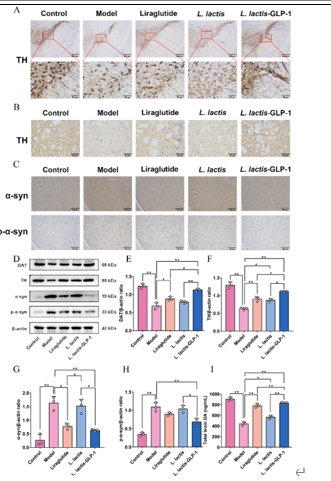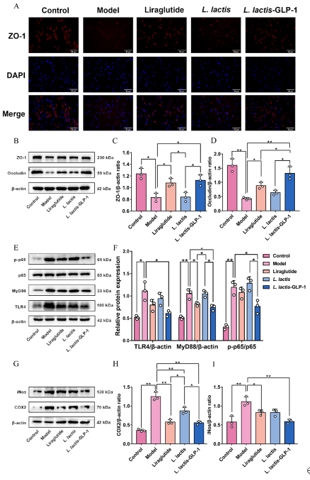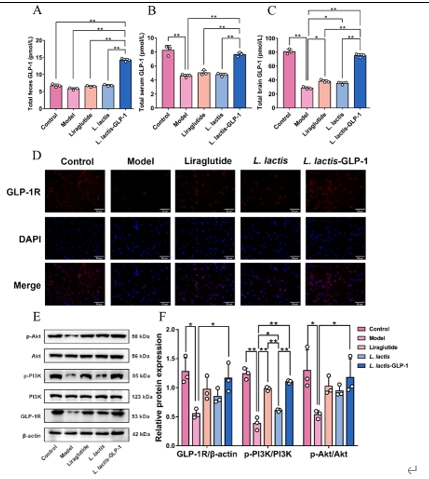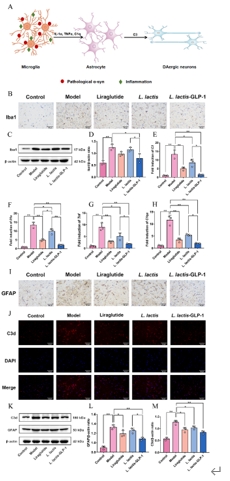中国神经再生研究(英文版) ›› 2026, Vol. 21 ›› Issue (3): 1211-1221.doi: 10.4103/NRR.NRR-D-24-00702
工程化益生菌乳链球菌MG1363-pMG36e-GLP-1调节转基因帕金森病模型小鼠小胶质细胞极化和肠道菌群失调
The engineered probiotic strain Lactococcus lactis MG1363-pMG36e-GLP-1 regulates microglial polarization and gut dysbiosis in a transgenic mouse model of Parkinson’s disease
Mengyun Yue1, *, #, Tingtao Chen2, *, #, Wenjie Chen2, 3, Jing Wei2 , Bin Liao1 , Jie Zhang1 , Fangjun Li1 , Daojun Hong1 , Xin Fang1, *
- 1 Department of Neurology, The First Affiliated Hospital, Jiangxi Medical College, Nanchang University, Nanchang, Jiangxi Province, China; 2 National Engineering Research Center of Bioengineering Drugs and Technologies, Institute of Translational Medicine, Nanchang University, Nanchang, Jiangxi Province, China; 3 Queen Mary School, Jiangxi Medical College, Nanchang University, Nanchang, Jiangxi Province, China
摘要:
帕金森病的特征是与突触核病变相关的神经变性。既往研究表明,胰高血糖素肽1对1-甲基-4-苯基-1,2,3,6-四氢吡啶诱导的帕金森病模型小鼠具有积极作用。然而,胰高血糖素肽1在突触核蛋白自身功能障碍中的作用尚不清楚。为此,实验探索了乳链球菌MG1363-pMG36e-GLP-1(L. lactis-GLP-1)对SncaA53T转基因帕金森病小鼠的改善作用及机制。结果显示,L. lactis-GLP-1可抑制转基因小鼠中多巴胺能神经元的死亡、α-Syn的病理凝集,并改善其运动功能。同时,L. lactis-GLP-1还能通过下调脂多糖相关炎症,减少小胶质细胞和星形胶质细胞的脑激活以及促进黑质细胞存活胰高血糖素肽1受体/PI3K/Akt通路,进而表现出抗帕金森病作用。此外,L. lactis-GLP-1还下调了血清促炎分子脂多糖、脂多糖相关蛋白、白细胞介素1β和白细胞介素6水平。最后,肠道组织病理学和蛋白质印迹结果进一步表明,L. lactis-GLP-1可通过逆转SncaA53T转基因小鼠肠道菌群失调来改善肠道完整性蛋白并减少炎症反应。结果结果表明,L. lactis-GLP-1对SncaA53T转基因帕金森病小鼠的积极作用是通过介导小胶质细胞极化和逆转肠道菌群失调实现的。因而,L. lactis-GLP-1可能成为一种潜在的帕金森病的治疗药物。
https://orcid.org/0000-0001-7768-3127 (Xin Fang); https://orcid.org/0000-0002-0506-8536 (Tingtao Chen);
https://orcid.org/0000-0003-1221-3727 (Mengyun Yue); https://orcid.org/0000-0002-0078-3805 (Wenjie Chen); https://orcid.org/0000-0003-1380-3534 (Daojun Hong)




